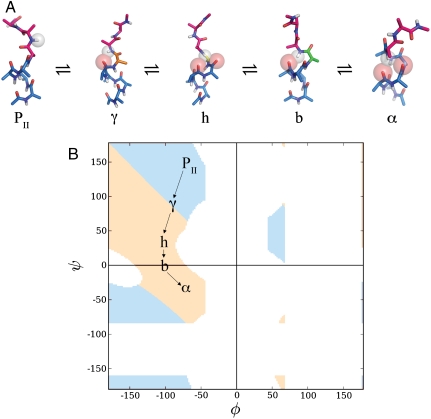Fig. 4.
Proposed low-energy pathway for helix formation. (A) Trajectory from PII to the α-basin via hydrogen-bond-preserving intermediates. The color-coded φ,ψ-angles of a probe residue are tracked from PII (pink,ϕ,ψ = -60,150)⇌inverse γ-turn (γ) (orange,ϕ,ψ = -75,80)⇌hybrid turn (h) (yellow,ϕ,ψ = -90,35)⇌bridge turn (b) (green,ϕ,ψ = -90,0)⇌α-helix (α) (blue, φ,ψ = -60, -40). Along this pathway, the N─H donor of interest forms consecutive hydrogen bonds with C═O acceptors as indicated: PII (none)⇌γ(i → i - 2)⇌h(i → i - 2 & i → i - 3)⇌b(i → i - 3)⇌α(i → i3 & i → i - 4). (B) Helical handedness in the Ramachandran plot. Repeated φ,ψ-angles give rise to either left-handed (blue region) or right-handed (peach region) helices. The low-energy pathway proposed here transits from left-handed polyproline II conformation to right-handed α-helical conformation, passing through an inflection point at the centroid of the γ-basin (φ,ψ = -80°, +80°). Map labels correspond to the φ,ψ-angles of conformers in A.

